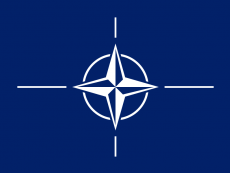
The North Atlantic Treaty Organisation, NATO, is an intergovernmental military alliance based on the 1949 Treaty of the same name. There are now 28 member nations, most from Europe or North America, each having sworn to the mutual defence of the other members.
Signed on the 4th April 1949, the North Atlantic Treaty was an important part of post World War II and early Cold War history. The Western powers were determined to prevent Soviet Russian expansion into Europe, to prevent a revival of nationalist militarism like that of Nazi Germany and to encourage European political integration, all with the help of the newly emerged American superpower. As the first NATO Secretary General Lord Ismay put it, the goal was to “keep the Russians out, the Americans in and the Germans down.” There were twelve founding nations: the United States, the United Kingdom, Belgium, Canada, Denmark, France, Iceland, Italy, Luxembourg, the Netherlands, Norway and Portugal. One of the key stipulations of the treaty is Article 4, which triggers not immediate military intervention but consultation when the “territorial integrity, political independence or security of any of the parties is threatened.” This is consolidated by Article 5 which states that an armed attack against one member state will be considered as an attack against them all.
The outbreak of the Korean War in 1952 prompted NATO to develop concrete military plans, where before it had been little more than a political association. The War presented the threat of worldwide Communist countries working together, and prompted concerns that Europe would not be strong enough to prevent this. NATO’s command structure was consolidated: the Supreme Headquarters of Allied Powers in Europe (SHAPE) was formed, under the command of future President Dwight D Eisenhower, to direct forces in Europe. At the same time the NATO Military Committee called for a build up of military forces in order to meet the power of the Soviets. Consequently there was an expansion to 35 continent-wide divisions, as well as an increased supply of nuclear weapons. By the height of the Cold War in the 1980s the, by then 16, member nations maintained around 5 million active military personnel under 78 headquarters.
In 1954 the Soviet Union suggested that it should join NATO in order to preserve peace in Europe. However, the existing members feared that its motive was to weaken the alliance from within, and therefore rejected the plan. When West Germany joined the Alliance in 1955, this prompted Russia to form a rival association with Hungary, Czechoslovakia, Poland, Bulgaria, Romania, Albania and East Germany under the Warsaw Pact. For the next few decades the presence of the Warsaw Pact would define NATO's actions.
In 1978 NATO countries officially defined two complementary aims of their Alliance. One of these was the policy of détente, from the French for relaxation, which called for an easing of the strained relationship with the Soviets. They also aimed to match the military capabilities of the Warsaw Pact countries, but without spurring a further arms race. An earlier 1954 Document issued by the Military Committee stated that the Alliance would have to use nuclear weapons at the onset of war with the Soviets, regardless of whether or not Russia used them first. This was part of a policy known as Massive Retaliation, which was meant to deter either side from deploying nuclear weapons by guaranteeing their mutual destruction in such an event. For instance in 1979 NATO approved the deployment of US cruise and nuclear missiles after the Warsaw Pact continued to build up its arms.
The end of the Cold War began with the revolutions of 1989, when Communism fell in throughout Eastern Europe. By the end of 1991 the Soviet Union had dissolved, and the Warsaw Pact was formally disbanded. It had been NATO’s main adversary for nearly four decades, and consequently this period saw a re-focusing of the Alliance’s aims. The 1990 Treaty on Conventional Armed Forces mandated military reductions across the continent, alongside a restructuring of the forces. There also began an expansion into the newly autonomous Eastern European nations. NATO had conducted no military interventions during the Cold War. Some of its first were undertaken during the Bosnian war from 1992, when NATO troops enforced a no-fly zone and later conducted bombing campaigns. Later the 1994 Partnership for Peace program aimed to create trust between NATO and the states of the former Soviet Union. By 1999 Hungary, Czech Republic and Poland became the first former Warsaw Pact countries to join the Alliance.
The 2001 9/11 attacks in New York saw Article 5 invoked for the first time in NATO’s history. From October 2001 to May 2002 Operation Eagle Assist had 13 NATO nations conducting over 360 flights in US airspace, while Operation Active Endeavour continues to prevent the movement of terrorists or weapons of mass destruction in the Mediterranean.
Image: https://upload.wikimedia.org/wikipedia/commons/thumb/3/37/Flag_of_NATO.svg/800px-Flag_of_NATO.svg.png

0 Comment:
Be the first one to comment on this article.